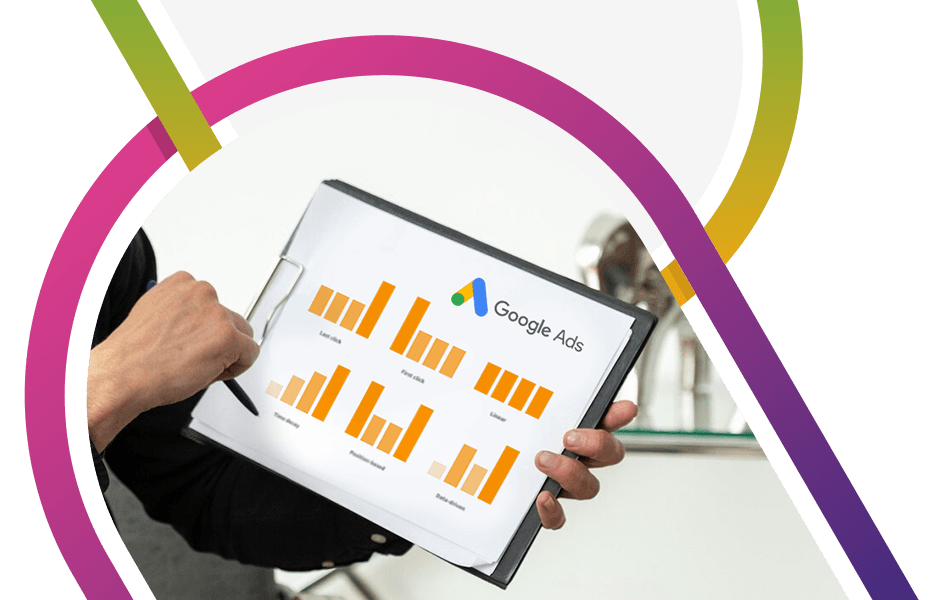
Free Digital Marketing Review
Elevate your online strategy with a personalised report and expert insights. Achieve your business goals faster!
Google Ads Attribution Models Explained: Maximising ROI Across Your Customer Journey
A potential customer discovers your business through a Google Ad on their mobile during lunch, researches your services on their laptop that evening, and converts three days later after clicking a remarketing ad. Which interaction should get credit for that sale?
This scenario plays out thousands of times daily for businesses, yet many marketers struggle to understand which touchpoints truly drive conversions. Getting Google Ads attribution wrong can waste 20-40% of your advertising budget on channels that appear effective but aren’t actually driving results.
This guide will help you choose the right attribution model to accurately measure your marketing performance and maximise every pound of your advertising spend.
Understanding Attribution Models: The Foundation of Smart Advertising
Attribution models are systematic rules that assign conversion credit across different customer touchpoints. Think of them as scoring systems that determine which marketing efforts deserve recognition for generating sales.
Why does this matter for your business?
- Budget efficiency: In today’s competitive market, accurate attribution ensures you invest in channels that actually convert prospects into customers, not just those that appear last in the journey.
- Multi-device reality: Modern customers research on smartphones and often purchase on desktops, creating complex conversion paths that simple attribution models miss entirely.
- Extended purchase cycles: Whether you’re selling enterprise software or luxury goods, customers typically interact with your brand multiple times before buying.
The Six Attribution Models: Which Fits Your Business?
Last Click Attribution
How it works: Awards 100% conversion credit to the final ad click before purchase.
Ideal for: Businesses with immediate conversion intent, such as emergency dental services or same day delivery companies.
First Click Attribution
How it works: Gives all credit to the initial ad that introduced the customer to your brand.
Ideal for: Brand awareness campaigns where discovery drives long term value.
Linear Attribution
How it works: Splits conversion credit equally among all touchpoints in the customer journey.
Ideal for: Complex B2B sales with multiple stakeholders and extended consideration periods.
Time Decay Attribution
How it works: Assigns increasing credit to touchpoints closer to the conversion moment.
Ideal for: Sales processes where closing activities matter most.
Position Based Attribution (40/20/40 Model)
How it works: Allocates 40% credit to each of the first and last touchpoints, distributing the remaining 20% among the middle interactions.
Ideal for: E-commerce businesses valuing both customer acquisition and conversion optimisation equally.
Data Driven Attribution
How it works: Uses machine learning to analyse your specific conversion paths and assign credit based on actual impact.
Ideal for: Large accounts with substantial data (typically 15,000+ clicks and 600+ conversions monthly).
Selecting Your Attribution Model: A Strategic Framework
Match Your Business Model
E-commerce retailers: Position based or data driven models typically work best, as customers often research extensively before purchasing.
Local service providers: Last-click attribution may suffice if customers convert immediately after finding your business.
B2B companies: Linear or Time Decay models better reflect extended sales cycles with multiple touchpoints.
Consider Journey Complexity
- Simple journeys (same-day conversion): Last Click or First Click
- Moderate complexity (2-7 days): Time Decay or Position Based
- Complex journeys (weeks/months): Linear or Data Driven
Evaluate Data Requirements
Data driven attribution needs significant traffic volume. Start with rule-based models and transition to data driven as your account scales.
Avoiding Common Attribution Mistakes
The Last Click Trap
Defaulting to last click attribution without considering actual customer behaviour creates three critical problems:
- Undervaluing awareness campaigns that introduce customers to your brand
- Overvaluing branded search terms that capture existing demand rather than creating it
- Missing audience building opportunities that drive long term growth
Cross Device Blindness
Many customers research on mobile and purchase on desktop. Ensure your attribution model captures these cross-device journeys through proper tracking setup.
Set-and-Forget Mentality
Customer behaviour evolves, especially post-pandemic. Review your attribution model quarterly to maintain accuracy.
Implementation: Your Step-by-Step Action Plan
Step 1: Current State Analysis
- Identify your existing attribution model in Google Ads
- Use Google Analytics to analyse typical customer journey length
- Document obvious attribution gaps in your current setup
Step 2: Model Selection
- Choose position based if uncertain about your optimal approach
- Plan migration to data driven once you reach sufficient data thresholds
- Consider using different models for distinct campaign objectives
Step 3: Technical Setup
- Enable enhanced conversions for improved cross device tracking
- Implement Google Tag Manager for consistent measurement
- Configure value-based bidding strategies where applicable
Step 4: Ongoing Optimisation
- Monitor performance across different attribution windows
- Reallocate budgets based on new attribution insights
- Document findings for future strategic decisions
Measuring Success: Expected Impact on Your ROI
Businesses switching from Last Click to more sophisticated attribution typically experience:
- 20-35% improvement in conversion volume through better budget allocation
- Enhanced ROAS accuracy leading to more informed strategic decisions
- Improved automated bidding performance as Google’s algorithms receive better conversion data
- Reduced cost per acquisition by identifying and scaling truly effective touchpoints
Key Implementation Takeaways
Attribution models fundamentally shape how you measure and optimise your Google Ads performance. The right choice depends on your business type, the complexity of your customer journey, and the available data volume.
Data driven attribution offers the most accuracy for accounts with sufficient traffic, while position based provides a balanced approach for most businesses transitioning from Last Click.
Success requires ongoing monitoring and optimisation; attribution isn’t a one time setup decision.
Transform Your Attribution Strategy Today
Understanding attribution theory is valuable, but implementing the right model for your specific business needs delivers measurable results.
If you’re ready to audit your current attribution setup and discover which model could optimise your Google Ads performance, our certified specialists can help you navigate this crucial decision.

Need help with your website and marketing?
Book a FREE growth strategy session with our experts
Our award-winning team will review your website and marketing goals to provide you with crucial insight and advice.

4.9 STAR
Google reviews
With 10+ years of experience, Link Digital has helped hundreds of businesses to succeed online. We can help yours too!

